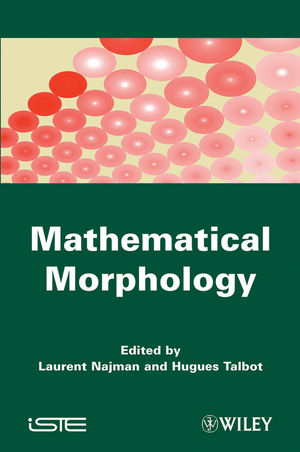
Mathematical Morphology
ISTE Ltd and John Wiley & Sons Inc (Verlag)
978-1-84821-215-2 (ISBN)
- Titel z.Zt. nicht lieferbar
- Versandkostenfrei
- Auch auf Rechnung
- Artikel merken
Mathematical Morphology allows for the analysis and processing of geometrical structures using techniques based on the fields of set theory, lattice theory, topology, and random functions. It is the basis of morphological image processing, and finds applications in fields including digital image processing (DSP), as well as areas for graphs, surface meshes, solids, and other spatial structures. This book presents an up-to-date treatment of mathematical morphology, based on the three pillars that made it an important field of theoretical work and practical application: a solid theoretical foundation, a large body of applications and an efficient implementation.
The book is divided into five parts and includes 20 chapters. The five parts are structured as follows:
Part I sets out the fundamental aspects of the discipline, starting with a general introduction, followed by two more theory-focused chapters, one addressing its mathematical structure and including an updated formalism, which is the result of several decades of work.
Part II extends this formalism to some non-deterministic aspects of the theory, in particular detailing links with other disciplines such as stereology, geostatistics and fuzzy logic.
Part III addresses the theory of morphological filtering and segmentation, featuring modern connected approaches, from both theoretical and practical aspects.
Part IV features practical aspects of mathematical morphology, in particular how to deal with color and multivariate data, links to discrete geometry and topology, and some algorithmic aspects; without which applications would be impossible.
Part V showcases all the previously noted fields of work through a sample of interesting, representative and varied applications.
Laurent Najman is Professor in the Informatics Department of ESIEE, Paris and a member of the Institut Gaspard Monge, Paris-Est Marne-la-Vallée University in France. His current research interest is discrete mathematical morphology. Hugues Talbot is Associate Professor at ESIEE, Paris, France. His research interests include mathematical morphology, image segmentation, thin feature analysis, texture analysis, discrete and continuous optimization and associated algorithms.
Preface xv
PART I. FOUNDATIONS 1
Chapter 1. Introduction to Mathematical Morphology 3
Laurent NAJMAN, Hugues TALBOT
1.1. First steps with mathematical morphology: dilations and erosions 4
1.2. Morphological filtering 12
1.3. Residues 22
1.4. Distance transform, skeletons and granulometric curves 24
1.5. Hierarchies and the watershed transform 30
1.6. Some concluding thoughts 33
Chapter 2. Algebraic Foundations of Morphology 35
Christian RONSE, Jean SERRA
2.1. Introduction 35
2.2. Complete lattices 36
2.3. Examples of lattices 42
2.4. Closings and openings 51
2.5. Adjunctions 56
2.6. Connections and connective segmentation 64
2.7. Morphological filtering and hierarchies 75
Chapter 3.Watersheds in Discrete Spaces 81
Gilles BERTRAND, Michel COUPRIE, Jean COUSTY, Laurent NAJMAN
3.1. Watersheds on the vertices of a graph 82
3.2. Watershed cuts: watershed on the edges of a graph 90
3.3. Watersheds in complexes 101
PART II. EVALUATING AND DECIDING 109
Chapter 4. An Introduction to Measurement Theory for Image Analysis 111
Hugues TALBOT, Jean SERRA, Laurent NAJMAN
4.1. Introduction 111
4.2. General requirements 112
4.3. Convex ring and Minkowski functionals 113
4.4. Stereology and Minkowski functionals 119
4.5. Change in scale and stationarity 121
4.6. Individual objects and granulometries 122
4.7. Gray-level extension 128
4.8. As a conclusion 130
Chapter 5. Stochastic Methods 133
Christian LANTUÉJOUL
5.1. Introduction 133
5.2. Random transformation 134
5.3. Random image 138
Chapter 6. Fuzzy Sets and Mathematical Morphology 155
Isabelle BLOCH
6.1. Introduction 155
6.2. Background to fuzzy sets 156
6.3. Fuzzy dilations and erosions from duality principle 160
6.4. Fuzzy dilations and erosions from adjunction principle 165
6.5. Links between approaches 167
6.6. Application to the definition of spatial relations 170
6.7. Conclusion 176
PART III. FILTERING AND CONNECTIVITY 177
Chapter 7. Connected Operators based on Tree Pruning Strategies 179
Philippe SALEMBIER
7.1. Introduction 179
7.2. Connected operators 181
7.3. Tree representation and connected operator 182
7.4. Tree pruning 187
7.5. Conclusions 198
Chapter 8. Levelings 199
Jean SERRA, Corinne VACHIER, Fernand MEYER
8.1. Introduction 199
8.2. Set-theoretical leveling 200
8.3. Numerical levelings 209
8.4. Discrete levelings 214
8.5. Bibliographical comment 227
Chapter 9. Segmentation,Minimum Spanning Tree and Hierarchies 229
Fernand MEYER, Laurent NAJMAN
9.1. Introduction 229
9.2. Preamble: watersheds, floodings and plateaus 230
9.3. Hierarchies of segmentations 237
9.4. Computing contours saliency maps 252
9.5. Using hierarchies for segmentation 255
9.6. Lattice of hierarchies 258
PART IV. LINKS AND EXTENSIONS 263
Chapter 10. Distance, Granulometry and Skeleton 265
Michel COUPRIE, Hugues TALBOT
10.1. Skeletons 265
10.2. Skeletons in discrete spaces 269
10.3. Granulometric families and skeletons 270
10.4. Discrete distances 275
10.5. Bisector function 279
10.6. Homotopic transformations 280
10.7. Conclusion 289
Chapter 11. Color and Multivariate Images 291
Jesus ANGULO, Jocelyn CHANUSSOT
11.1. Introduction 291
11.2. Basic notions and notation 292
11.3. Morphological operators for color filtering 299
11.4. Mathematical morphology and color segmentation 312
11.5. Conclusion 320
Chapter 12. Algorithms for Mathematical Morphology 323
Thierry GÉRAUD, Hugues TALBOT, Marc VAN DROOGENBROECK
12.1. Introduction 323
12.2. Translation of definitions and algorithms 324
12.3. Taxonomy of algorithms 329
12.4. Geodesic reconstruction example 334
12.5. Historical perspectives and bibliography notes 344
12.6. Conclusions 352
PART V. APPLICATIONS 355
Chapter 13. Diatom Identification with Mathematical Morphology 357
Michael WILKINSON, Erik URBACH, Andre JALBA, Jos ROERDINK
13.1. Introduction 357
13.2. Morphological curvature scale space 358
13.3. Scale-space feature extraction 359
13.4. 2D size-shape pattern spectra 359
13.5. Datasets 364
13.6. Results 364
13.7. Conclusions 365
Chapter 14. Spatio-temporal Cardiac Segmentation 367
Jean COUSTY, Laurent NAJMAN, Michel COUPRIE
14.1.Which objects of interest? 368
14.2. How do we segment? 369
14.3. Results, conclusions and perspectives 372
Chapter 15. 3D Angiographic Image Segmentation 375
Benoît NAEGEL, Nicolas PASSAT, Christian RONSE
15.1. Context 375
15.2. Anatomical knowledge modeling 376
15.3. Hit-or-miss transform 378
15.4. Application: two vessel segmentation examples 378
15.5. Conclusion 383
Chapter 16. Compression 385
Beatriz MARCOTEGUI, Philippe SALEMBIER
16.1. Introduction 385
16.2. Morphological multiscale decomposition 385
16.3. Region-based decomposition 389
16.4. Conclusions 391
Chapter 17. Satellite Imagery and Digital ElevationModels 393
Pierre SOILLE
17.1. Introduction 393
17.2. On the specificity of satellite images 394
17.3. Mosaicing of satellite images 398
17.4. Applications to digital elevation models 400
17.5. Conclusion and perspectives 405
Chapter 18. Document Image Applications 407
Dan BLOOMBERG, Luc VINCENT
18.1. Introduction 407
18.2. Applications 409
Chapter 19. Analysis and Modeling of 3D Microstructures 421
Dominique JEULIN
19.1. Introduction 421
19.3. Models of random multiscale structures 431
19.4. Digital materials 440
19.5. Conclusion 444
Chapter 20. Random Spreads and Forest Fires 445
Jean SERRA
20.1. Introduction 445
20.2. Random spread 448
20.3. Forecast of the burnt zones 451
20.4. Discussion: estimating and choosing 453
20.5. Conclusions 454
Bibliography 457
List of Authors 499
Index 501
| Verlagsort | London |
|---|---|
| Sprache | englisch |
| Maße | 158 x 236 mm |
| Gewicht | 907 g |
| Themenwelt | Naturwissenschaften ► Physik / Astronomie ► Mechanik |
| Technik ► Elektrotechnik / Energietechnik | |
| ISBN-10 | 1-84821-215-1 / 1848212151 |
| ISBN-13 | 978-1-84821-215-2 / 9781848212152 |
| Zustand | Neuware |
| Informationen gemäß Produktsicherheitsverordnung (GPSR) | |
| Haben Sie eine Frage zum Produkt? |
aus dem Bereich


